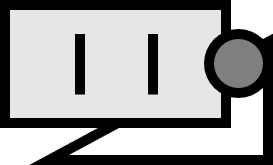ベクトル空間で定義される基底の方向
定義 1
$$ U = \left\{ \mathbf{u}_{1}, \cdots, \mathbf{u}_{n} \right\} \\ V = \left\{ \mathbf{v}_{1}, \cdots, \mathbf{v}_{n} \right\} $$ 二つの順序のある集合$U,V$がベクトル空間$X$の基底だとして、行列$\left( a_{ij} \right) \in \mathbb{C}^{n \times n}$を次の式が満たされるように定義しよう。 $$ \mathbf{v}_{j} = \sum_{i=1}^{n} a_{ij} \mathbf{u}_{i} $$ この時 $\det \left( a_{ij} \right) > 0$ならば$U,V$は同じ向きorientationであるといい、$\det \left( a_{ij} \right) < 0$ならば違う向きであるという。
特にユークリッド空間$X = \mathbb{R}^{n}$では、向きには名前がある。
- $\mathbb{R}^{2}$での基底$\left\{ \mathbf{e}_{2}, \mathbf{e}_{1} \right\}$は時計回りの方向だ。
- $\mathbb{R}^{3}$での基底$\left\{ \mathbf{e}_{1}, \mathbf{e}_{2}, \mathbf{e}_{3} \right\}$は右手の法則の方向だ。
- $\mathbf{e}_{k}$は$k$番目の成分だけが$1$で他は$0$の単位ベクトル$\left( 0, \cdots , 0, 1, 0 ,\cdots ,0 \right) $だ。
説明
向きの定義では、二つの基底には順序があることに注意しよう。向きは行列式で判断されるため、この順序が変わると行列$\left( a_{ij} \right)$の行と列が交換され、その都度符号も正確に一度ずつ反転する。
幾何学的に向きを定義する理由は難しくないはずだ。$2$次元平面$\mathbb{R}^{2}$で$\mathbf{e}_{2} \to \mathbf{e}_{1}$は時計の針が動く方向、$3$次元空間$\mathbb{R}^{3}$で$\mathbf{e}_{1} \to \mathbf{e}_{2} \to \mathbf{e}_{3}$は親指を立てて右手が内側に巻き込まれる形を思い浮かべればいい。$4$次元以上からは、このような概念が適用されないため、正確に名前がつけられず、二つの基底が同じか違うかだけを考えるしかない。
例
$$ \begin{align*} \mathbf{u}_{1} =& \mathbf{e}_{1} & \mathbf{v}_{1} =& \left( 1, 1, 0 \right) \\ \mathbf{u}_{2} =& \mathbf{e}_{2} & \mathbf{v}_{2} =& \left( 1, 0, -1 \right) \\ \mathbf{u}_{3} =& \mathbf{e}_{3} & \mathbf{v}_{3} =& \left( 2, 1, 3 \right) \end{align*} $$
$\mathbb{R}^{3}$で上記のような二つの基底を考えれば、 $$ \begin{align*} \mathbf{v}_{1} = \left( 1, 1, 0 \right) =& 1 \mathbf{e}_{1} + 1 \mathbf{e}_{2} + 0 \mathbf{e}_{3} \\ \mathbf{v}_{2} = \left( 1, 0, -1 \right) =& 1 \mathbf{e}_{1} + 0 \mathbf{e}_{2} - 1 \mathbf{e}_{3} \\ \mathbf{v}_{3} = \left( 2, 1, 3 \right) =& 2 \mathbf{e}_{1} + 1 \mathbf{e}_{2} + 3 \mathbf{e}_{3} \end{align*} $$ 行列$\left( a_{ij} \right)$は $$ \begin{bmatrix} 1 & 1 & 2 \\ 1 & 0 & 1 \\ 0 & -1 & 3 \end{bmatrix} $$ のように定義され、その行列式は $$ \begin{align*} \det \left( a_{ij} \right) =& 1 \cdot (0 \cdot 3 - (-1)\cdot 1) \\ && - 1 \cdot ( 1 \cdot 3 - (-1) \cdot 2 ) \\ & + 0 \cdot ( 1 \cdot 1 - 0 \cdot 2 ) \\ =& 1 - 5 + 0 \\ =& -4 \\ <& 0 \end{align*} $$ なので、二つの基底は向きが異なる。
Millman. (1977). Elements of Differential Geometry: p6. ↩︎
